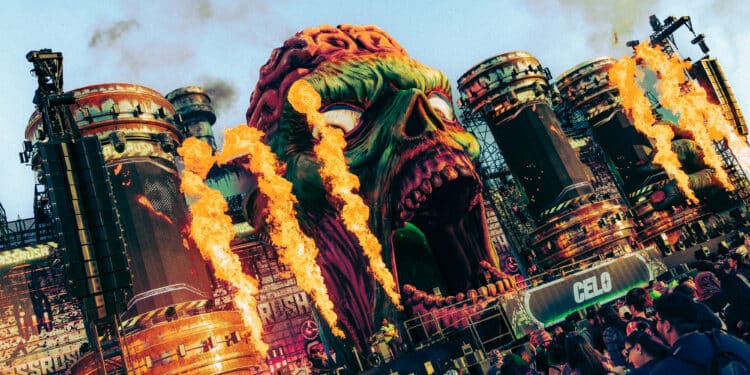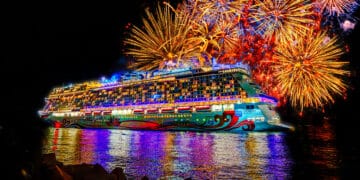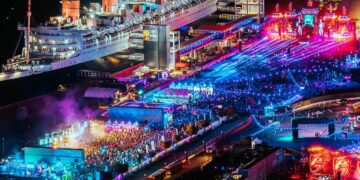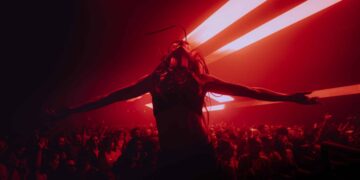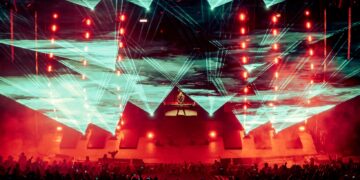Outside Lands celebrated 15 years and put San Francisco’s culture on display with acts that perfectly fit each of the six stages.
From August 11-13, nearly 200,000 people from all across the country flocked to San Francisco‘s Golden Gate Park for Outside Lands. Though some from outside of the Bay Area might not have expected the cold temperatures and thick blanket of fog that settled on the Park each day, they knew to expect a weekend full of amazing music, incredible refreshments, and endless memories.
Embedded in every aspect of Outside Lands is San Francisco’s history and culture. All food and drink vendors are local, the festival’s mascots are beloved park rangers, and most importantly, each stage is named after a landmark in the city. Six larger stages spread throughout the grounds – Lands End, Twin Peaks, Sutro, Panhandle, the SOMA Tent, and Dolores – each have their own unique identities that match their namesakes, and performing artists who also fit the vibe. Let’s journey through this year’s Outside Lands as we explore each stage.

Brand new this year was Dolores, a celebration of San Francisco’s LGBTQ+ history, and thriving queer and trans communities.
Placed at the edge of the polo field and visible from the main stage was the open air dance space Dolores. Strewn in pink and yellow ribbon with disco balls suspended throughout the area, this new addition takes its name from Mission Dolores and Dolores Park, which sit on the edge of San Francisco’s Mission and Castro Districts, and at the intersection of numerous San Francisco demographics. The 1960s and ’70s gave rise to Castro’s gay culture, and it has since been at the heart of LGBTQ+ activism. The district is also known for being home to Harvey Milk, the first openly gay man to be elected to public office in California. Today, Dolores Park and the Castro remain integral to the queer community in SF.
Dolores was programmed by three local, queer and trans nightlife powerhouses: FAKE and GAY, OASIS, and Hard French. The beats were bumping and good times were had all weekend with DJ sets, drag performances, and music selections spanning all genres from pop to reggaeton, and soul and electronic. Dolores’ energy could be heard and felt all across the polo field, drawing in partygoers like a magnet. The area was fun, colorful, and celebratory, giving attendees a space to be themselves and let go of inhibition. Dolores was such a wonderful addition that we hope it returns for many Outside Lands to come.

For better or for worse, the SOMA Tent made its third appearance, and brought with it a whole host of challenges.
Standing for “South Of Market,” the SoMa neighborhood of San Francisco lies (obviously) south of Market Street and is home to various museums, Oracle Park, and many of the city’s clubs and nightlife destinations. The SOMA Tent was introduced in 2021 as an ode to underground nightlife culture, offering nonstop house music all weekend. The enclosed space included lighting and production that emulated a nightclub, and this year the stage featured artists like BLOND:ISH, Claptone, Justin Jay, Tinlicker, Âme B2B Trikk, Sama’ Abdulhadi, and many more.
In theory, the SOMA Tent sounds like a great idea. Similar to its Coachella counterpart, the Yuma Tent, it would offer a destination for pulsing beats and dance music. In execution, however, the tent was more or less a disaster. Personally, I’ve never even attempted to enter SOMA because the line is always insane. A giant crowd that never seem to subside subject themselves to a one or two-hour wait just to enter. Once inside, its hot, dark, and in 2021 was even a super spreader event.
The problems this year didn’t stop there. On Friday during Disco Lines‘ set, aggressive jumping and dancing caused the floor to break. Luckily, no one was hurt but this caused the tent to close for the remainder of the day, cancelling all remaining sets as well. These problems didn’t seem to be resolved on day two as the tent was once again closed after just a few acts. By day three, it was announced that SOMA would become an open-air stage, a decision bemoaned by many. Everything seemed like too little, too late. Hopefully, if some semblance of SOMA returns in future years, they embrace the open-air concept from the beginning.

One of the more inviting stages on the festival grounds is the Panhandle Stage, purveyor of more chill vibes.
On the way to the Twin Peaks stage, you’ll come across the Panhandle. Adorned with vibrant murals of San Francisco’s famed Painted Ladies this year, the stage is named after a long and narrow park that forms a panhandle with Golden Gate Park. In the 1870s, the area around the Panhandle extending to the Pacific Ocean largely consisted of sand dunes and little vegetation. This area was known as the “Outside Lands.” Efforts to turn the Outside Lands into a recreational park started where the current Panhandle is now.
The name is apt because the more intimate, inviting vibes of the Panhandle stage allow for music discovery and a place to rest within the festival. As the space offers plenty of food options close by and open grass to sit on, attendees can enjoy rising or local artists across varied genres. From folk offerings of Izzy Heltai to ambient electronica from Monolink to Chicano-influenced hip-hop and rap from Eddie Zuko and Soccer Mommy‘s indie rock, there are so many chances to stumble upon new artists. Crowds here are generally more low key and less packed as well.

Tucked away in Lindley Meadow, the Sutro Stage is the hidden life of the party at Outside Lands.
On the far northwest corner of San Francisco is the Sutro Historic District, which was home to former mayor Adolph Sutro, the Cliff House, and the Sutro Baths. Opened in 1896 and once the largest indoor public bath house, the Sutro Baths were enclosed by a glass ceiling and housed seven swimming pools, some of which could be filled and recycled during high tide. Among other attractions were exhibitions of artifacts from around the globe, and music performances were regularly hosted as well, enticing visitors to spend their whole days there. Eventually, the baths lost popularity and were destroyed by fire in 1966. The ruins that remain today can still be visited.
Much like the Sutro Baths, which kept all visitors entertained, the Sutro Stage is always one of our favorites. Though larger than the Panhandle, Sutro still manages to feel intimate due to its location. In the northwest corner of the festival grounds, the stage sits nestled in a small valley which creates a sense of enclosure. This year we caught sets there from artists including Willow, Mariah the Scientist, and Nora En Pure. Standout favorites included French band L’Imperatrice and FISHER. Both sets were high energy and there was plenty of space to dance. You can’t go wrong at the Sutro.

Twin Peaks is the second largest stage at Outside Lands and often brings the most energy.
As it stands 952 feet in elevation, reaching Twin Peaks is quite the trek — but the trip is worth it! The two peaks at the top are the second and third highest mountains in San Francisco and sit almost directly in the center of the city. Once up there — and if you’re lucky enough to come on a clear day — Twin Peaks offers a 360° view of the skyline, bridges, and the Bay. This spectacular vantage point draws tourists and locals alike, making Twin Peaks one of the most popular stops in San Francisco.
The Twin Peaks Stage is also one of the most popular at the festival, despite requiring quite the trek to get to from the main stage or entrances. Similar to the Sutro, the hills on both sides of the stage create a valley that pulls the crowd close together. This didn’t pose a problem at some of our favorite sets like Becky Hill, Evan Giia, NIKI, and Zedd. But in years past, and during popular sets by the likes of Diesel and Lana Del Rey, things can get really tight in there really fast. Fighting crowds for parking and a spot to take a photo at the actual Twin Peaks and dealing with pushy crowds at the stage can feel like one and the same, but that doesn’t stop either from being a must-visit!

The heart of Outside Lands is the main Lands End Stage, where some of the most legendary acts have performed and electronic music history was made this year.
The entire area in the northwest corner of San Francisco is known as Lands End. Gusty winds, rocky cliffs, and countless hiking trails give way to stunning views of the Marin County, Golden Gate Bridge, and Pacific Ocean. Journeying along the coastal trail will bring you to many historic landmarks including the Sutro Baths, making this hike one of the best in San Francisco.
The festival, meanwhile, all ends and begins at the Lands End Stage. Located at the end of the polo field, this stage is emblematic of Outside Lands. With the iconic windmills in view (inspired by the Dutch windmills found in Golden Gate Park), countless food stands flanking each side, and the Bay Bridge sat atop the stage, Lands End is the image that comes to mind when you think of the festival. Its expansive polo field allows for everyone to enjoy sets here with plenty of room.
This year saw performances from some of the biggest names in music including Janelle Monae, Kendrick Lamar, Maggie Rogers, The Foo Fighters, and Megan Thee Stallion. But the pinnacle for us was Sunday headliner ODESZA. The first-ever electronic act to headline Outside Lands drew a massive, well-deserved crowd and blew away all in attendance. From set list to production, it was amazing to see one of our favorite acts play on such a large scale. The fireworks lit up the sky as ODESZA filled our hearts.

This year’s Outside Lands ended up being one of our favorites. It’s hard to beat the picturesque setting, but pairing that with top-notch music, the best food the Bay Area has to offer, and so many experiences to explore makes Outside Lands unbeatable. We implore those visiting for the festival to go explore the city as well. With such a storied history and so much to discover, San Francisco has a lot to offer. But for those that may not have time to venture, wandering from stage to stage in itself is like a tour of the city.



